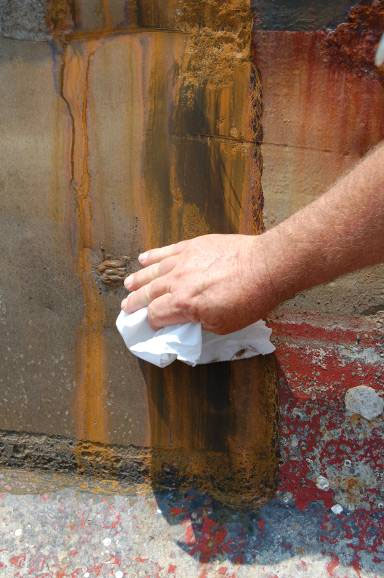Mega Rust Workshop
Date : 2009-03-12
2 Separate Workshops on “How to Inspect for Flash Rust”
To replace the description sent out on 2009-03-09
Contact Person: Lydia Frenzel
Frenzel tried to cover two workshops with one write-up. This was confusing to some people.
The tag line “Practical Solutions for Practical Problems” reflects Dr. Frenzel’s approach to life with the “Keep it Simple Stupid” approach. If you are an inspector and never been on a waterjetting job, OR If you have ever been in an argument concerning light, moderate, or heavy flash rust, this workshop is for you.
Here are two separate Press Releases.
=================================
Who: Lydia Frenzel
Date: June 8, 2009
Where: Megarust, Norfolk, VA
For Registration : www.nstcenter.com
Description: Surface Preparation using WaterJet or Wet Abrasive Blast Cleaning. \How to Inspect for Flash Rust.
You will learn how to Inspect for FLASH RUST
WHAT happens to the SURFACE?
This four hour interactive workshop will feature “HOW TO INSPECT FLASH RUST” –new training material, funded by National Shipbuilding Research Program, that augments the FROSIO, NACE and SSPC Coating Inspector Courses.
How the acceptance of Waterjet Cleaning has changed the industry’s view on what is Surface Preparation over the past 30 years.
This workshop includes, but is not limited to:
What is “flash rust?”
How do you reduce the amount of Flash Rust during the project?
Field Examples of 4 methods to determine the amount of flash rust
Wiping with cloth held in hand
Wiping with swatch of cloth
Wiping with Brush
Tape Pull Test
What does the surface look like after pressure washing?
What are the field studies of 20 years showing on the performance of coatings over surfaces cleaned with hand-held and robotic waterjet systems?
Certificate of Attendance and dvd will be issued
Level of Competence- All levels- certified inspectors, engineers, contractors, specifiers, jetters
Sponsored by: Advisory Council and MegaRust
Spend personal time with Dr. Lydia Frenzel, “Waterwitch of the West”, and the chair of the SSPC/NACE waterjetting and water-abrasive committees, and author of SSPC C-13 WJ course.
=======================
Who: Dr. Lydia Frenzel, and other industry Experts
Date: Tuesday August 18,2009
Where: WJTA Conference, Houston Texas
For Registration: www.wjta.org for details
Cost: $280- $340 for Tuesday workshop only;
You can register for the workshop without registering for the entire WJTA conference.
Description: “Waterjet Technology, Basics and Beyond,”- Full day Course
“Waterjet Technology, Basics and Beyond” –
The morning sessions cover the waterjet technology basics: history (30 minutes), equipment (40 minutes), applications (50 minutes) and safety (50 minutes)
Afternoon: 2 hour break out sessions covering: Cleaning Applications, Cutting Applications, Hydro-Excavation and Surface Preparation Applications, followed by Panel Q&A
The Surface Preparation session will feature “HOW TO INSPECT FLASH RUST” –new training material, funded by National Shipbuilding Research Program, that augments the FROSIO, NACE and SSPC Coating Inspector Courses.
This workshop includes, but is not limited to:
What is “flash rust?”
How do you reduce the amount of Flash Rust during the project?
Field Examples of 4 methods to determine the amount of flash rust
Wiping with cloth held in hand
Wiping with swatch of cloth
Wiping with Brush
Tape Pull Test
What does the surface look like after pressure washing?
Time permitting: How the acceptance of Waterjet Cleaning has changed the industry’s view on what is Surface Preparation over the past 30 years.
Certificate of Attendance and dvd will be issued
Level of Competence- All levels- certified inspectors, engineers, contractors, specifiers, jetters
Sponsored by: Advisory Council and WJTA
Spend personal time with Dr. Lydia Frenzel, “Waterwitch of the West”, and the chair of the SSPC/NACE waterjetting and water-abrasive committees, and author of SSPC C-13 WJ course.
========
Lydia M. Frenzel
PO Box 2139
San Marcos TX 78667
Tel/Fax (1) 800-308-7416












April 5, 2009
Comments Off on Thermal Spray Coatings